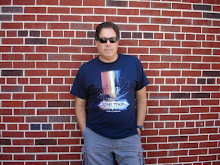
(May 1954, U.S.)
So, it seems that we move from the previously-posted Hitchcock-STYLE film to an actual Hitchcock film. Nice!
One of the first things I should tell you is that I'm not going to bother discussing the whole 3-D aspect of this release. I consider it practically irrelevant to the film itself and Hitchcock's film making style. I am also of the opinion that 3-D is one of the stupidest movie gimmick ever created, whether it was in the 1950s, the 1980s or the digital technology that plagues movie theaters today. Poor Hitchcock was practically forced to make this film in 3-D because that's what the times demanded back then. Sorry, Alfred.
DIAL M FOR MURDER was a very successful stage play before it was adapted to the screen. Like some of Hitchcock's other work (i.e., ROPE and REAR WINDOW), the setting is mostly confined to a single room. This has a knack of cleverly bringing the viewer inside to follow the action and dialogue between characters on a much closer level. The key word here is confinement, and sometimes when you're confined to a space you're forced to pay closer attention to your surroundings. As the film begins it's interesting to note that within just the first two minutes of the story we learn that Margot Wendice (played by screen legend and popular Hitchcock blonde Grace Kelly) has a nice marriage to her husband, retired tennis star Tony Wendice (played by Ray Milland) and an even nicer love affair with Mark Halliday (played by Robert Cummings). Take careful note in Hitchcock's use of color in that Margot is wearing an innocent white dress when she's with her husband and a sinful red dress when she's with her lover (shows you where HER head and body are at!). Within a short time of that, we learn that Tony not only knows of her infidelities but is also plotting her murder. Actually, let me correct that...he meets with petty criminal C.A. Swann (played by Anthony Dawson), an old acquaintance from Cambridge University whom Tony has been following in order to blackmail him into committing the murder of his wife. Swann reluctantly agrees, but as you would naturally expect, things go horrible wrong and Swann is killed by Margot with a pair of scissors in self-defense. Things go wrong even further when Margot is ultimately accused of, tried and sentenced for the murder of Swann, which suits Tony just fine as he can ultimately get rid of her, one way or another. But it's thanks to Chief Inspector Hubbard (played by John Williams) and some very clever deductions regarding house keys that will finally free the good guy (girl) and bring the bad guy (Tony) to justice. And just like an Agatha Christie resolution, you'll need to pay close and careful attention to the end and how the entire business with the latch keys ultimately solves the entire puzzle. Oh, but what a fun puzzle the whole thing is - Hitchcock style!
Favorite line or dialogue:
Inspector Hubbard: "Well, Mr. Halliday, have you got it?"
Mark Halliday: "I don't think so. Where's Mrs. Wendice's key?"
(Hubbard reveals the key from under the stair carpet)
Hubbard: "It took me just half an hour to find it."
Mark: "But if it was there, why didn't Wendice use it just now?"
Hubbard: "Well, he didn't use it because he doesn't realize it's there. He still thinks it's in his wife's handbag. You see, you were very nearly right. He told Swann that he would leave your latch key under the stair carpet, Mrs. Wendice, and told him to return it to the same place when he left. But as Swann was killed, we naturally assumed that your key would still be in one of Swann's pockets. That was his little mistake. Swann had done exactly as you suggested, Mr. Halliday. He unlocked the door and returned the key BEFORE he came in."
Mark: "And it's been out there ever since. And the key Wendice took out of Swann's pocket and returned to her handbag was..."
Hubbard: "Swann's OWN latch key."


No comments:
Post a Comment